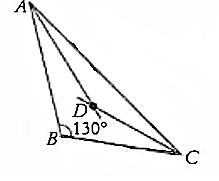 Multiple Choice Questions
Multiple Choice QuestionsIf one angle of a triangle is 130°, then the angle between the bisectors of the other two angles is
65°
115°
130°
155°
D.
155°

According to the question, B = 130°
Let AD and CD be the bisectors of A and C respectively
So By angle sum property
A + B + C = 180°
A + C = 180°-130°
A + C = 50°
= 25°
In ADC
ADC + DAC + DCA = 180°
ADC + = 180°
ADC + 25° = 180°
ADC = 180°-25° = 155°
Four times the area of the curved surface of a cylinder is equal to 6 times the sum of the areas of its bases. If its height is 12 cm, then its volume (in cm3) is
48
546
768
X runs twice as fast as Y and Y runs thrice as fast as Z. The distance covered by Zin 72 min, will be covered by X
24min
18min
16min
12min
"In a triangle, if two sides are equal, then the angles opposite to equal sides have equal measures." The inverse of this theorem will be
In a triangle, if the angles opposite to two sides have equal measures, then the two sides are equal
In a triangle, if two sides are not equal, then the angles opposite to these two sides do not have equal measures
In a triangle, if its measures of angles opposite to two sides are not equal, then the two sides are not equal
All of the above
The sum of all interior angles of a regular convex polygon is 1080°. The measure of each of its interior angles
1080
1350
720
1200
